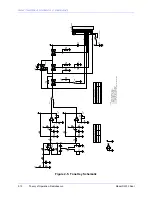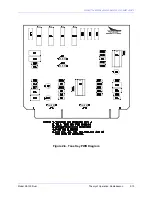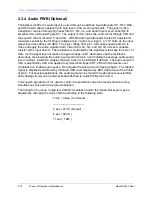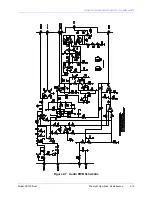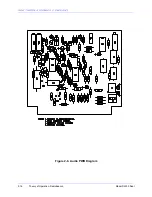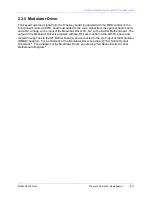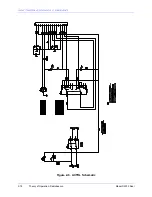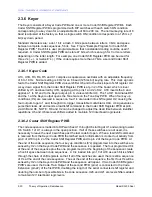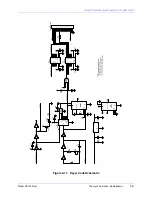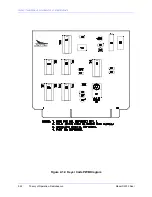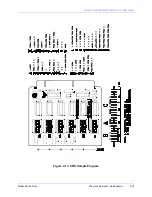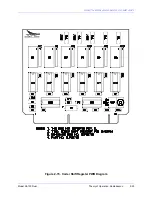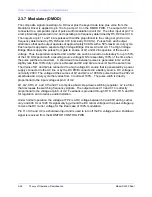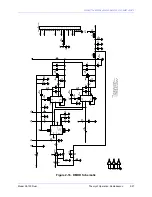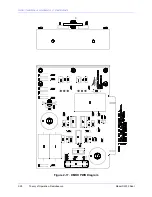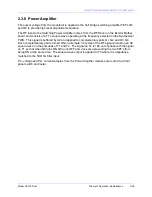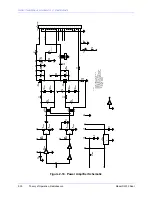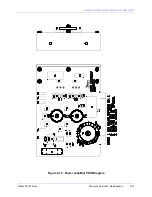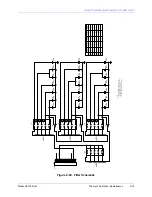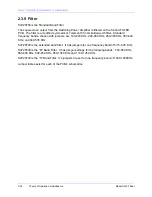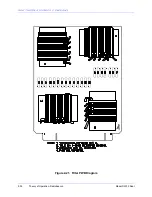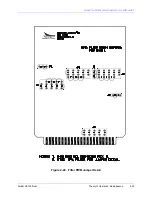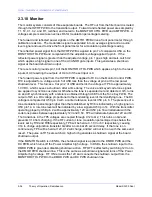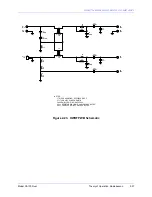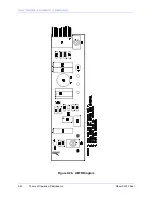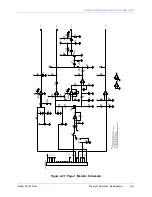
SOUTHERN AVIONICS COMPANY
Model SA100 Dual
2-26
Theory of Operation, Radiobeacon
2.3.7 Modulator (DMOD)
The composite signal consisting of a DC level plus the keyed code tone plus voice from the
Modulator Driver is applied to pin 10 of op amp U1C on the DMOD PWB. The output of U1C is
connected to a comparator input of pulse width modulation circuit U2. The other input at pin 7 is
a ramp internally generated in U2, and operating at a frequency determined by R5, R23 and C18.
The outputs at pin 11 and 14 are pulses with widths proportional to the voltage at pin 9 and a
frequency determined by R5, R23 and C18 (nominally 100 KHz). Pulses from each output
alternate so that each output operates at approximately 50 KHz with a 50% maximum duty cycle.
Each output is applied to separate High Voltage Bridge Drivers U3 and U4. The High Voltage
Bridge Drivers apply the pulses from gate to source of Q1 and Q2 irrespective of the source
voltage. Thus the parallel connected Q1 and Q2 can each be turned on alternately for up to 50%
of the 100 KHz period with a resulting source voltage ON for essentially 100% of the time when
the pulse widths are maximum. A short dead time between pulses is generated in U2 so that
slightly less than 100% duty cycle is achieved and Q1 and Q2 are never ON at the same time.
The drains of Q1 and Q2 are connected to a high voltage DC source that is generated by a power
supply connected to the AC line or by the DC PWB connected to a battery source. DC voltage is
nominally 200V. The voltage at the sources of Q1 and Q2 is a 100 KHz pulse train with a 200 volt
amplitude and a duty cycle that varies from 0 to almost 100%. The pulse width is directly
proportional to the input voltage at pin 9 of U2.
Q1, Q2, CR3, L1, and C13 and C14 comprise a basic step-down switching regulator. L2 is a filter
that decreases the switching frequency signals. The output across C13 and C14 is directly
proportional to the voltage at pin 9 of U2. Feedback is provided through R16, C15, R15, and R3
for regulation and to reduce audio distortion.
Under normal operation, the voltage at TP2 is a DC voltage between 60 and 80V during carrier
only, and 400 Hz or 1020 Hz signal varying around the DC carrier voltage with a peak voltage up
to twice the DC carrier voltage for the ideal case of 100% modulation.
Pin 11 of U3 and U4 is a shutdown input and is used to turn off the PA voltage when a shutdown
signal is received from the MONITOR CONTROL PWB.
Summary of Contents for SA100
Page 20: ...SOUTHERN AVIONICS COMPANY Model SA100 Dual x Contents...
Page 22: ...SOUTHERN AVIONICS COMPANY Model SA100 Dual 1 2 Introduction This page intentionally left blank...
Page 25: ...SOUTHERN AVIONICS COMPANY Model SA100 Dual 1 5 Introduction Figure 1 2 Transmitter Portrait...
Page 26: ...SOUTHERN AVIONICS COMPANY Model SA100 Dual 1 6 Introduction This page intentionally left blank...
Page 28: ...SOUTHERN AVIONICS COMPANY Model SA100 Dual 1 8 Introduction This page intentionally left blank...
Page 119: ...SOUTHERN AVIONICS COMPANY Model SA100 Dual 3 3 Antennas Figure 3 1 Antenna Reactance...
Page 120: ...SOUTHERN AVIONICS COMPANY Model SA100 Dual 3 4 Antennas This page intentionally left blank...
Page 160: ...SOUTHERN AVIONICS COMPANY Model SA100 Dual 5 8 Maintenance This page intentionally left blank...
Page 162: ...SOUTHERN AVIONICS COMPANY Model SA100 Dual 6 2 Parts List This page intentionally left blank...
Page 164: ...SOUTHERN AVIONICS COMPANY Model SA100 Dual 6 4 Parts List This page intentionally left blank...
Page 218: ...SOUTHERN AVIONICS COMPANY Model SA100 Dual 6 58 Parts List This page intentionally left blank...

